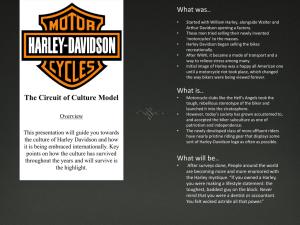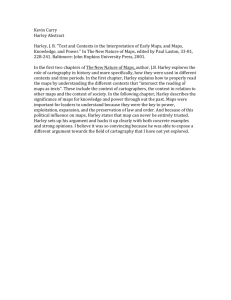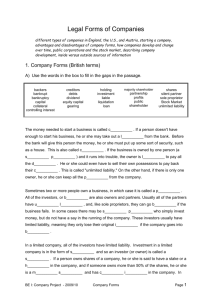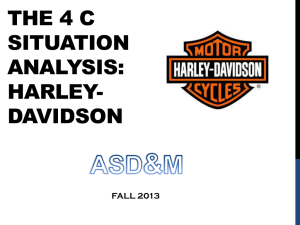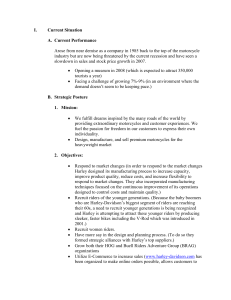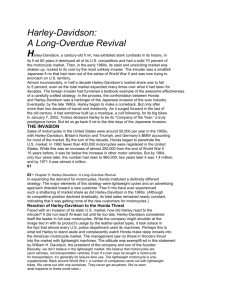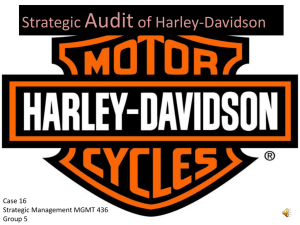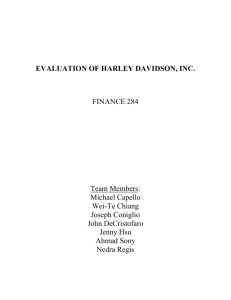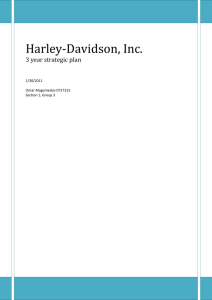Harley Davidson Group 2
advertisement
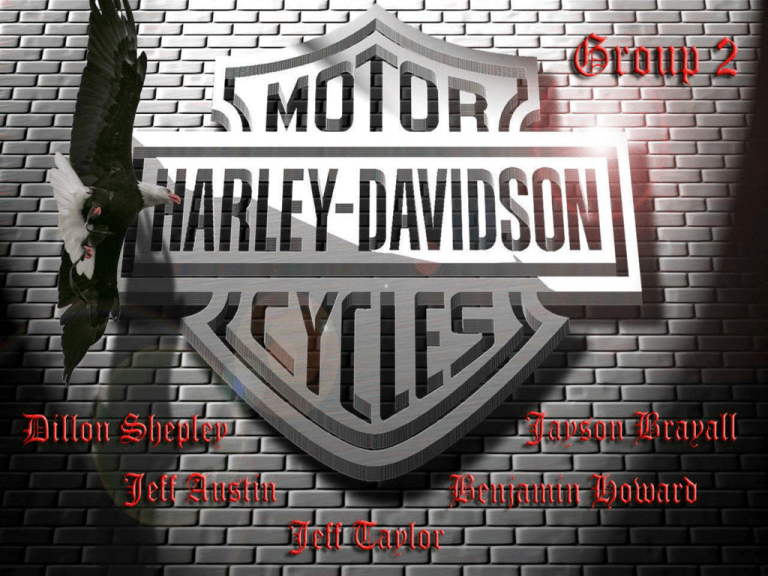
I. Current Situation Dillon Shepley A. Current Performance Arose from near demise as a company in 1985 back to the top of the motorcycle industry but are now being threatened by the current recession and have seen a slowdown in sales and stock price growth in 2007. • Opening a museum in 2008 • Facing a challenge of growing 7%-9% I. Current Situation Dillon Shepley B. Strategic Posture 1. Mission • We fulfill dreams inspired by the many roads of the world by providing extraordinary motorcycles and customer experiences. We fuel the passion for freedom in our customers to express their own individuality. • Design, manufacture, and sell premium motorcycles for the heavyweight market I. Current Situation Dillon Shepley B. Strategic Posture 2. Objectives • Respond to market changes • Recruit riders of the younger generations. • Recruit women riders. • Have more say in the design and planning process. • Grow both their HOG and Buell Riders Adventure Group (BRAG) organizations • Utilize E-Commerce to increase sales • Survive the recession • Stay on top of the heavyweight motorcycle market. • Increase safety awareness I. Current Situation Dillon Shepley B. Strategic Posture 3. Strategies • Acquired Buell Motorcycle Company in 1993. • Acquired Eaglemark Financial services to produce revenues from customer credit. • Internal makeover of the company • Use technology to cut back on communication times and administrative trivia. • Introduce bikes that appeal to younger generations and international markets. • Introduced a new beginner rider’s course aimed at the first time Harley owner and rider. • Introduced 17 year old Jennifer Snyder as the newest member of the Harley Davidson racing team. • Partnered with Jane magazine in 2005 • Held Harley Owners Group rallies (HOG) I. Current Situation B. Strategic Posture 4. Policies • • • • • • Maintain the quality Harley-Davidson image. Traditional styling Design simplicity Durability Ease of service Evolutionary change Dillon Shepley II. Strategic Managers Jayson Brayall A. Board of Directors 1. A substantial majority of the Directors on the Board (9 of 11) are independent. a) • • • • • • Stock rose 23,000% since going public (1986-2006) Core business - resonates w/ ‘motor heads & suits’ Graying of its prime sector (med age = 47) Shifting & tuning focus – younger/sports world riders World expansion = XX digit growth, weakening N. American Ops Grow brand in Latin America, Asia (India/China) & EU. II. Strategic Managers Jayson Brayall A. Board of Directors 1. A substantial majority of the Directors on the Board (9 of 11) are independent. b) • Stock symbol = HOG • Director(Non mgt) AN retainer of $100K, at least ½ to be paid in common stock • Encourages SR Mgmt to interact w/ the Directors • Audit , HR, $Comp & Nominating & Corp Governance Cmtes = Independents • Furthering steps for compliance to enviro- emissions, noise & safety stnds- which positions it better for EU and Japanese mkts II. Strategic Managers Jayson Brayall A. Board of Directors 1. A substantial majority of the Directors on the Board (9 of 11) are independent. c) • • • • • • • • • Specialization & Experience (Core & Expansion) Technical Engineering Transportation & Logistics (SCM) Dealer relationships Recapitalization / Private to Public M&A / Leveraged Buy-Outs / Corp Law Financial e-Busn, IT, TeleCom, Media International Mkting & Merchandizing II. Strategic Managers Jayson Brayall B. Top Management • 50% of all Harley employees ride the brand • CEO & Board’s direction to Mgmt intimately know customers design / offer great products operational excellence mfr’ing & Supply Chain Mgmt (SCM) • Direction to strengthen credit division (including franchising (wholesale & retail) income stream • ‘Top 100 Global Brands’ and in Fortune’s ‘Most Admired Companies’ and Forbes ‘Company of the Year’ • Mkt confidence buying back stock during a multi-year repurchase effort valued over $200M. II. Strategic Managers Jayson Brayall B. Top Management • Mgmt Accused of stock manipulation forcing dealers to accept stock(book corp sales) US dealers, 80% sold Harley’s exclusively - burdened to shoulder costs until sold more bikes • 2004- retiring CEO made $40M w/ pay & stock options • Several class action lawsuits filed (‘06) claiming Board & Mgmt fraud • Main Production – York, PA- (‘07) full contract strike Management Makeup • Next to no info published regarding experience / backgrounds or $compensation for the Mgmt team • Harley’s By-Laws- Director & Mgmt Pay = cash & stocks; restricted, deferred & nonqualified options Exhibit #5A Harley-Davidson_Exhibit 5A (In thousands, except per-share amnts) Income statement data: Net revenue Cost of goods sold Gross profit Financial services income Financial services expense Operating income from financial services Selling, administrative and engineering expense Income from operations Investment income Interest expense Income before provision for income taxes Provision for income taxes Net income Weighted-average common shares: Basic Diluted Earnings per common share:(in dollars) Basic Diluted Dividends paid per common share Jayson Brayall 2008 2007 5,594,307 3,663,488 1,930,819 376,970 294,205 82,765 984,560 1,029,024 9,495 4,542 1,033,977 379,259 654,718 5,726,848 3,612,748 2,114,100 416,196 204,027 212,169 900,708 1,425,561 22,258 0 1,447,819 513,976 933,843 234,225 234,477 2.80 2.79 1.29 1.29 249,205 249,882 3.75 3.74 1.06 1.06 Exhibit #5B Harley-Davidson_Exhibit 5B (In thousands, except per-share amnts) Balance sheet data: Jayson Brayall 2008 2007 2006 Working capital 2,774,124 1,562,235 1,954,956 Finance receivables held for sale 2,443,965 781,280 547,106 Finance receivables held for investment, net 2,195,563 2,420,327 2,280,217 Total assets 7,828,625 5,656,606 5,532,150 Current debt 1,738,649 1,119,955 832,491 Long-term debt 2,176,238 980,000 870,000 Total debt 3,914,887 2,099,955 1,702,491 Shareholder equity Number of shareholders of record 2,115,603 89,298 2,375,491 90,748 2,756,737 88,995 Exhibit #5C Jayson Brayall Harley-Davidson_Exhibit 5C Assets, Depreciation & Capital Expenditures Yr Ending Dec 31 (Ammount In thousands) Motorcycles & Related Products Finacial Services 2007 Identifiable Assets Depreciation and Amortization Net Capital Expenditures 1,804,202 3,447,075 197,655 6,517 232,139 9,974 2006 Identifiable Assets Depreciation and Amortization Net Capital Expenditures 1,683,724 2,951,896 205,954 7,815 209,055 10,547 2005 Identifiable Assets Depreciation and Amortization Net Capital Expenditures 2,845,802 2,363,235 198,833 6,872 188,078 10,311 III. External Environment Jeff Austin A. Natural Physical Environment: Sustainability Issues • • Harley has been very wary of raw material usage and purchase recently. The biggest concern for Harley when considering environmental issues will be seasonal changes. B. Societal Environment 1. Economic • • • • • The current recession will be a continual threat (T) Expansion into China (O) Growth in target rider market (O) Restructuring cost could exceed $110 million (T) Many wholesaler and retailer compete to carry the Harley name (O) III. External Environment Jeff Austin B. Societal Environment 2. Technological • Research and development of new motorcycles to appeal to different rider groups (O) • Development of faster, sleeker motorcycles to appeal to younger market (O) • Redesigned manufacturing process geared toward cost reduction and flexibility to market changes (O) • R&D bring professional and employees together to consider redesign and product creation (O) • R&D spent over $163 million (T) • Internet sales available to public market (O) III. External Environment Jeff Austin B. Societal Environment 3. Political/Legal • Regulations concerned with air, water, and noise pollution (T) • Product recall to ensure consumer safety (T) • Must rely on independent dealers for sales (T) 4. Socio Cultural • • • • • Restructuring will close numerous plants down (T)(O) Reaching out to younger generation and female riders (O) Offer for new riders to participate in Rider’s Edge program (O) New product offerings for non-riding public (O) Sponsorship of local events and races (O) III. External Environment Jeff Austin C. Task Environment • Threat of new entrants – Low - Harley has the history to repel any new production or competitor • Bargaining powers of buyers – Medium – They are not the only motorcycle dealer, one bad experience from a consumer may send them looking toward Honda or Kawasaki. • Threat of substitute products or service – Low – No imitators known at this time • Bargaining power of suppliers – Medium • Rivalry among competing firms – High – Previously mentioned competitors jockey for market groups targeted by Harley • Power of unions, government, special interest groups – Low III. External Environment Jeff Austin D. Summary of External Factors External Factors Weight Ratin g Weighted Comments Score Threats Opportunities Current recession 0.15 4.3 0.645 Huge opportunity in expanding westernized market Expansion into China Marketing to different rider market Redesign of manufactoring process New product offerings Product development 0.2 4.2 Regulations 0.84 Chance to sell to younger generation and females 0.1 3 Restructuring of operations 0.05 0.05 2.8 2.7 0.14 0.135 0.05 0.15 2.2 3.3 3 Air,emissions, and noise pollution a factor may lose local vendors/stakeholde rs 0.3 Eliminates unnecassary plants 0.05 sales could be affected due to lack of finances R&D expenses 0.11 0.165 0.45 0.05 clothing lines are big sellers Product recall sportier bikes attract different markets Independent dealers 0.1 Totals 1 0.05 3.3 3.7 2.6 0.165 0.185 0.26 3.395 will extreme R&D expenses jeopardize revenue could blemish public image may affect pricing and sales income IV. Internal Environment Jeff Taylor A. Corporate Structure • Harley-Davidson has an 11 member Board of Directors consisting of 9 nonemployee and 2 employee members. They serve in three-year staggered terms. • The president and CEO, James C. Ziemer has set three constants for success that he expects his employees to follow closely. • There is no information provided describing the decision making process or the timeline for major decisions to be made. B. Corporate Culture • Management pushes the employees to see what the customers see so they make the employees go through a dealer to purchase their bikes if they buy them. 50% of the employees ride Harleys, so this accounts for a great deal of training. • The employees are offered opportunities to obtain union representation to make sure they are taken care of for their hard work. • The CEO implements 3 main objectives for success: Passion for the business, sense of purpose, and operational excellence. IV. Internal Environment Jeff Taylor C. Corporate Resources 1. Marketing • Most marketing efforts are divided between dealer promotions, customer events, magazine and mail advertising, public relations, cooperative programs with dealers, and national television ads. • Harley-Davidson stays involved with all major motorcycle consumer shows and rallies, and also sponsors racing activities and different promotional events. 2. Finance • Since Harley went public, its shares have risen over 23,000%. As of February 2008, there are over 90,000 shareholders of Harley-Davidson common stock. • Due to the down economy in 2007, the company experienced their first declines in over 20 years. Motorcycle revenue dropped 1.27% and total revenue fell 0.69%. The biggest decline during this time was a 10.74% drop in operating income. • Between 2003 and 2006, net income rose grew by over 30%. IV. Internal Environment Jeff Taylor C. Corporate Resources 3. Research and Development • Harley strongly believes that research and development is a factor in keeping them in the front of the market for custom and touring motorcycles, and ready to develop products for the performance segment. • They have a Product Development Center (PDC) that brings employees from styling, purchasing, and manufacturing together with regulatory professionals, and supplier representatives to create a well rounded process development team. • Over the span of 2005 to 2007, research and development expenses averaged over $180.5 million a year. IV. Internal Environment Jeff Taylor C. Corporate Resources 4. Operations and Logistics • Research and development leading to the company entering the market for both female and younger riders helped them stay at the head of the motorcycling industry. • Harley sells its products at wholesale to a group of around 684 independentlyowned full-service Harley-Davidson dealerships. 5. Human Resources Management • The relationships with unions and employees are typically very good. • As of the end of 2007, there are 9,000 employees working for the company. The majority of these employees are unionized and have representation from either the Paper Allied-Industrial Chemical and Energy Workers International Union, or the International Association of Machinist and Aerospace Workers. IV. Internal Environment Jeff Taylor C. Corporate Resources 6. Information Technology • IT systems are not mentioned in this case. • Garry Berryman, an intense procurement expert, brought Harley’s top suppliers into the design and planning process because he felt that new technology and the Internet would make it very easy to form bonds this way. Exhibit #2 Jeff Taylor Table 5-2 Internal Factor Analysis Summary Internal Factors Weight Rating Weighted Score Comments Strengths: Employee unions Male and female customers of all ages Rider training and safety programs Foreign operations Harley Owners Group (H.O.G.) 0.05 3 0.15 Employee representation 0.2 4.5 0.9 Broad customer base 0.1 0.15 4 4.2 0.4 0.63 0.15 3.9 0.59 Offered by Harley Quickly growing Largest motorcycle club on Earth Weaknesses: Image of who rides Harleys Performance market 0.15 0.05 4.2 1.2 0.63 0.06 Expensive 0.1 3.1 0.31 Advertising 0.05 1.9 0.1 Total scores 1 3.77 Negative stigma assosiated with brand Not involved enough No options for lowermiddle class Don't reach put to potential riders V. Analysis of Strategic Factors A. Situational Analysis (SWOT) Benjamin Howard 1. Strengths • Net income of 2003 was $760mn, its more than 30% as compared to the previous year. • The standard and performance segments of Harley Davidson make up 70% of the European heavy weight motorcycle market • Harley-Davidson operates in two segments: Harley-Davidson motorcycles & related products and HDFS (Harley-Davidson Financial Services). • Harley-Davidson is the only major American heavyweight motorcycle manufacturer. • Strong brand name. • The HOG (Harley Owners Group), which have a 7,50,000 members world wide is the industry’s largest company sponsored motorcycle enthusiast organization. • Buell Riders Adventure Group (BRAG) was also formed recent • Customization of the bikes, this is Harley-Davidson’s major revenue maker. • Harley-Davidson have a good marketing division and its divided as dealer promotions, customer events, magazine and direct-mail advertising, and public relations. V. Analysis of Strategic Factors Benjamin Howard A. Situational Analysis (SWOT) 2. Weaknesses • High price • Harley-Davidson has problems in gaining more market share in some European countries (That’s one of the main markets for Heavyweight motorcycles outside U.S). • They didn’t yet start its sales in India, one of the biggest markets. • Required production is not met, analyzing the future of Heavyweight motorcycle market V. Analysis of Strategic Factors Benjamin Howard A. Situational Analysis (SWOT) 3. Opportunities • The European demand for Harley Davidson is the highest in the international market and represents the single largest motorcycle market in the world. • Women and younger riders are increasing becoming interested in bikes • The international heavy weight market is growing and is now larger than the U. S. heavyweight market • Market share increasing in Europe and Asia for the last two years • Increasing demand in US markets for bikes • Customers value quality parts V. Analysis of Strategic Factors Benjamin Howard A. Situational Analysis (SWOT) 3. Threats • Harleys ongoing capacity restraints caused a shortage supply and a loss in domestic market share in recent years • Harleys average buying age is 42 years old and increasing • The European Union’s motorcycles noise standards are more stringent than those of Environmental Protection Agencies in the U.S and increased environmental stand • Some competitors of Harley Davidson have larger financial and marketing resources and they are more diversified • Environmental protection laws • Buell division needs to continue to produce a quality motorcycle under Harley’s brand name. V. Analysis of Strategic Factors Benjamin Howard B. Review of Current Mission and Objectives Mission Statement “We fulfill dreams through the experiences of motorcycling, by providing to motorcyclists and to the general public an expanding line of motorcycles, branded products and services in selected market segments” Objective To be branded as the best motorcycle in the world. Exhibit #4 Liquidity Ratio Current (Current Assets/Current Liabilities) Quick (current Assets-inventory/current liabilities) Leverage Ratio Debt to Total Assets (Total Debt/Total Assets) Debt To Equity (Total Debt/Total Assets) Activity Ratios Inventory Turnover-sales (Net Sales/Inventory) Average collection (days) (Inventory/COGS divided by 365) Benjamin Howard 2008 1.3 Fixed Asset Turnover (Sales/Fixed Asset) Total Asset Turnover (sales/total asset) 3.77% 1.87% 0.401 Profitability Ratios Gross Profit Margin (Sales-COGS/Net Sales) 42.30% 73% 8.74% 55 51.7% Net Operating Margin (Net Profit After taxes/Net Sales) 10.70% Profit Margin on Sales 1-(COGS/Sales) 35.08% Return on Total Assets (Net Profit After Taxes/Total Assets) 14.27% Return on Equity (Net Profit After taxes/Shareholder’s equity) 24.92% VI. Strategic Alternatives Jeff Austin A. Strategic Alternatives • • • Market development Marketing strategy Product development Alternatives and Pros and Cons • • • Operations strategy (This is a win lose situation for all involved) Purchasing strategy needs to be considered when selling and using raw materials. Logistics strategy can also be seen when discussing the consolidation of plants and distributors. VI. Recommended Strategy B. Recommended Strategy Benjamin Howard • Design to continuously improve product quality, increase productivity, reduce costs and increase flexibility to respond to changes in the marketplace • This market naturally wants something different from what the older generation rode. They are looking for more cool and sleek sport bikes • The Company continues to establish and reinforce long-term, mutually beneficial relationships with its suppliers. Through these collaborative relationships, the Company gains access to technical and commercial resources for application directly to product design, development and manufacturing initiatives • The Company must continue to be successful in promoting motorcycling to customers new to the sport of motorcycling including women, younger riders and more ethnically diverse riders • Harley has adopted several new marketing objectives to target the younger market with its new product line: expand its current market, diversify its product line, and modify its marketing mix to target a younger demographic VII. Implementation Jayson Brayall • Old facilities –v- efficient Asian competitor • Optimize production facilities & SCM • Strikes & reinventing labor interactions • Graying of its prime UW sector (med age = 47) • Retuning focus – young/sports riders- +up • World expansion = XX dig growth, weak N. American Ops- Grow brand in Latin America, Asia (India/China) & EU VIII. Evaluation and Control Jeff Taylor • Sales information is tracked to the specific dealer where the product was sold. Harley is able to record the age, gender, and even the household income of their buyers after most purchases. • The company identifies its strengths, weaknesses, opportunities and threats by carefully evaluating their customer feedback, monitoring the competition, and using an extensive research and development group. • Devising a system to suggest the most prominent locations for dealerships based on previously gathered information would be an effective way for Harley Davidson to position their company most efficiently.
